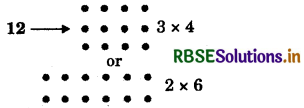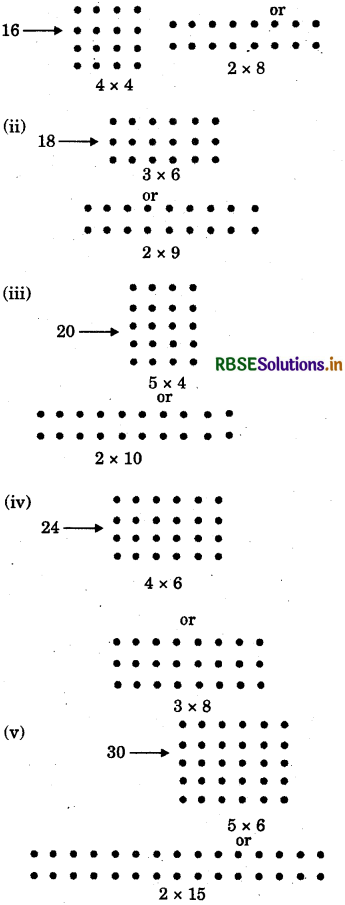RBSE Solutions for Class 6 Maths Chapter 2 Whole Numbers InText Questions
Rajasthan Board RBSE Solutions for Class 6 Maths Class 6 Maths Chapter 2 Try These Solutions Whole Numbers InText Questions Textbook Exercise Questions and Answers.
Rajasthan Board RBSE Solutions for Class 6 Maths in Hindi Medium & English Medium are part of RBSE Solutions for Class 6. Students can also read RBSE Class 6 Maths Important Questions for exam preparation. Students can also go through RBSE Class 6 Maths Notes to understand and remember the concepts easily. Students are advised to practice अनुपात और समानुपात के प्रश्न class 6 of the textbook questions.
Class 6 Maths Chapter 2 Try These Solutions
(Try These Page No: 28)
Question 1.
Write the predecessor and successor of 19, 1997, 12000, 49, 100000.
Answer:
(i) Predecessor of 19 = 19 - 1 = 18
Successor of 19 = 19 + 1 = 20
(ii) Predecessor of 1997 = 1997 - 1 = 1996
Successor of 1997 = 1997 + 1 = 1998
(iii) Predecessor of 12000 = 12000 - 1 = 11999
Successor of 12000 = 12000 + 1 = 12001
(iv) Predecessor of 49 = 49 - 1 = 48
Successor of 49 = 49 + 1 = 50
(v) Predecessor of 100000 = 100000 - 1 = 99999
Successor of 100000= 100000 + 1 = 100001

Question 2.
Is there any natural number that has no predecessor?
Answer:
Yes, 1 is a natural number that has no predecessor.
Question 3.
Is there any natural number which has no successor? Is there a last natural number?
Answer:
(i) No, each natural number has a successor.
(ii) No, there is no last natural number.
(Try These Page No: 29)
Question 1.
Are all natural numbers also whole numbers?
Answer:
Yes, because set of natural numbers with zero are whole numbers.
Question 2.
Are all whole numbers also natural numbers?
Answer:
No, because 0 is not a natural number.

Question 3.
Which is the smallest whole number ?
Answer:
0 is smallest whole number.
Question 4.
Which is the greatest whole number?
Answer:
There is no greatest whole number because every whole number has a successor.
(Try These Page No: 30)
Question 1.
Find 4 + 5; 2 + 6; 3 + 5 and 1 + 6 using the number line.
Answer:
(i) 4 + 5 = 9
Starting from 0,4 jumps towards right, we reach at 4. Now starting from 4, 5 jumps towards right, we reach at 9.
∴ 4 + 5 = 9

(ii) 2 + 6 = 8
Starting from 0, 2 jumps towards right, we reach at 2.
Now, starting from 2, 6 jumps towards right, we reach at 8.
∴ 2 + 6 = 8


(iii) 3 + 5 = 8
Starting from 0, 3 jumps towards right, we reach at 3. Now, starting from 3, 5 jumps towards right, we reach at 8.
∴ 3 + 5 = 8

(iv) 1 + 6 = 7
Starting from 0, 1 jump towards right, we reach at 1. .
Now, starting from 1, 6 jumps towards right, we reach at 7.
∴ 1 + 6 = 7

(Try These Page No: 30)
Question 1.
Find
(i) 8 - 3;
(ii) 6 - 2;
(iii) 9 - 6
using the number line.
Answer:
(i) 8 - 3

Start from 8 and move 3 units to the left.
We get 8 - 3 = 5

(ii) 6 - 2

Start from 6 and move 2 units to the left.
We get 6 - 2 = 4.
(iii) 9 - 6

Start from 9 and move 6 units to the left.
We get 9 - 6 = 3.
(Try These Page No: 31)
Question 1.
Find 2 × 6; 3 × 3; 4 × 2 using the number line.
Answer:
(i) 2 × 6
2 × 6 means 2 added 6 times.
Start from 0 make 6 jumps of 2 units each. We reach at 12.

(ii) 3 × 3 ,
3 × 3 means 3 added 3 times.
Starts from 0, make 3 jumps of 3 units each. We reach at 9.

(iii) 4 × 2
4 × 2 means 4 added 2 times.
Start from 0, make 2 jumps of 4 units each. We reach at 8.


(Verify Page No: 35)
Question 1.
(i) Subtraction is not commutative for whole numbers. Use at least three different pairs of numbers to verify it.
(ii) Is (6 + 3) same as (3 + 6) ? Justify it by taking few more combinations of whole numbers.
Answer:
(i) The subtraction of whole numbers is not commutative. If a and b are two whole numbers then in general (a - b) is not equal to (b - a).
Verify : (1) 8 - 5 = 3 but 5 - 8 = - 3 is not possible.
(2) 25 - 13 = 12 but 13 - 25 = - 12 is not possible.
(3) 125 - 110 = 15 but 110 - 125 = - 15 is not possible.
∴ Subtraction is not commutative.
(ii) 6 ÷ 3 = 2 and 3 ÷ 6 = \(\frac{1}{2}\)
⇒ 6 ÷ 3 ≠ 3 ÷ 6
Verify of Answer
(1) 20 ÷ 10 = 2 and 10 ÷ 20 = \(\frac{1}{2}\)
⇒ 20 ÷ 10 ≠ 10 ÷ 20
(2) 18 ÷ 6 = 3 and 6 ÷ 18 = \(\frac{1}{3}\)
⇒ 18 ÷ 6 ≠ 6 ÷ 18
(3) 100 ÷ 25 = 4 and 25 ÷ 100 = \(\frac{1}{4}\)
⇒ 100 ÷ 25 ≠ 25 + 100

(Try These Page No: 37)
Question 1.
Find 7 + 18 + 13; 16 + 12 + 4 using commutative and associative property.
Answer:
(i) 7 + 18 + 13
= 7 + 13 + 18
= 7 + (13 + 18)
= 7 + 31 = 38
(ii) 16 + 12 + 4= (16 + 12) + 4
= 28 + 4 = 32

(Try These Page No: 37)
Question 1.
Find 25 × 8358 × 4; 625 × 3759 × 8 by using commutative and associative property.
Answer:
(i) 25 × 8358 × 4 = 8358 × 4 × 25
= 4358 × (4 × 25)
= 8358 × 100
= 835800
(ii) 625 × 3759 × 8
= 3759 × 8 × 625
= 3759 × (8 × 625)
= 3759 × 5000
= 18795000
(Think, Discuss and Write Page No: 37)
Question 1.
(i) Is (16 ÷ 4) ÷ 2 = 16 ÷ (4 ÷ 2)?
Answer:
(i) (16 ÷ 4) ÷ 2 = 4 ÷ 2 = 2
16 ÷ (4 ÷ 2) = 16 ÷ 2 = 8 ≠ 2
∴ (16 ÷ 4) ÷ 2 ≠ 16 ÷ (4 ÷ 2)
(ii) Is there an associative property for division?
Answer:
There is no associative property for division.

(iii) Discuss with your friends. Think of
(28 ÷ 14) ÷ 2 and 28 ÷ (14 ÷ 2)
Answer:
Again, (28 ÷ 14) ÷ 2 = 2 ÷ 2 = 1
28 ÷ (14 ÷ 2) = 28 ÷ 7 = 4 ÷ 1
∴ (28 ÷ 14) ÷ 2 ≠ 28 ÷ (14 ÷ 2)
(Review Exercise Page No: 38)
Question 1.
Find using distributivity :
4 × (5 + 8); 6 × (7 + 9); 7 × (11 + 9)
Answer:
(i) 4 × (5 + 8) = 4 × 5 + 4 + 8
(Distributivity of multiplication over addition)
= 20 + 32 = 52
(i) 6 × (7 + 9) = 6 × 7 + 6 × 9
= 42 + 54 = 96
(ii) 7 × (11 + 9) = 7 × 11 + 7 × 9
= 77 + 63 = 140

(Try These Page No: 39)
Question 1.
Find 15 × 68; 17 × 23; 69 × 78 + 22 × 69 using distributive property.
Answer:
(i) 15 × 68 = 15 × (60 + 8)
= 15 × 60 + 15 × 8
= 900 + 120 = 1020
(ii) 17 × 23 = 17 × (20 + 3)
= 17 × 20 + 17 × 3
(Distributivity of multiplication over addition)
= 340 + 51 = 391
(iii) 69 × 78 + 22 × 69
= 69 × 78 + 69 × 22
(Commutativity of multiplication)
= 69 × (78 + 22)
= 69 × 100 = 6900
(Try These Page No: 42)
Question 1.
Which numbers can be shown only as a line?
Answer:
The numbers 2, 5, 7, 11, 13, 14, 17, 19, can be shown only as a line.
Question 2.
Which numbers can be shown as squares?
Answers:
Numbers 4, 9, 16, 25, 36 can be shown as squares.

Question 3.
Which numbers can be shown as rectangles?
Answer:
Numbers 4, 6, 8, 9, 10, 12 can be shown as rectangles.
Question 4.
Write down the first seven numbers that can be arranged as triangles.
Answer:
3, 6, 10, 15, 21, 28 and 36.
Question 5.
Some numbers can be shown by two rectangles. Give at least five examples:
(i)

Give at least five other such examples.
Answer:


- RBSE Class 6 Maths Important Questions Chapter 1 अपनी संख्याओं की जानकारी
- RBSE Solutions for Class 6 Maths Chapter 7 भिन्न Intext Questions
- RBSE Solutions for Class 6 Maths Chapter 7 Fractions Ex 7.4
- RBSE Solutions for Class 6 Maths Chapter 1 Knowing our Numbers Ex 1.1
- RBSE Solutions for Class 6 Maths Chapter 1 Knowing our Numbers InText Questions
- RBSE Solutions for Class 6 Maths in Hindi Medium & English Medium
- RBSE Solutions for Class 6 Maths Chapter 7 Fractions InText Questions
- RBSE Solutions for Class 6 Maths Chapter 7 Fractions Ex 7.6
- RBSE Solutions for Class 6 Maths Chapter 7 Fractions Ex 7.5
- RBSE Solutions for Class 6 Maths Chapter 7 Fractions Ex 7.3
- RBSE Solutions for Class 6 Maths Chapter 4 Basic Geometrical Ideas InText Questions